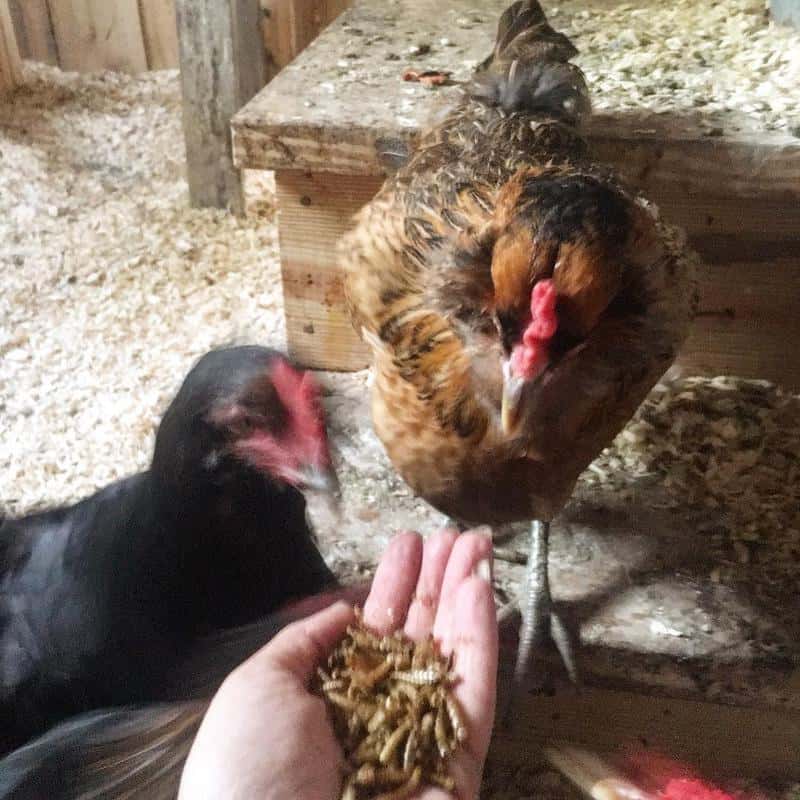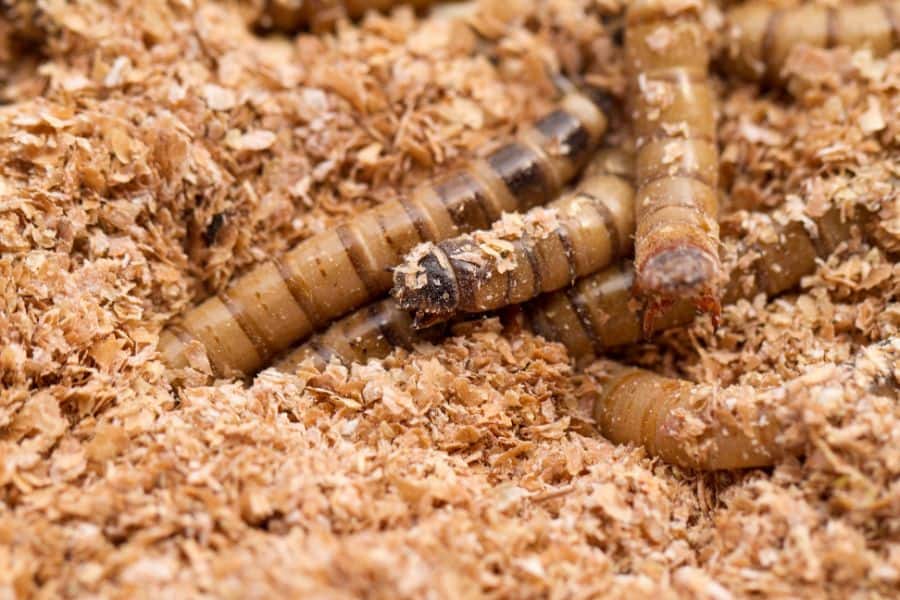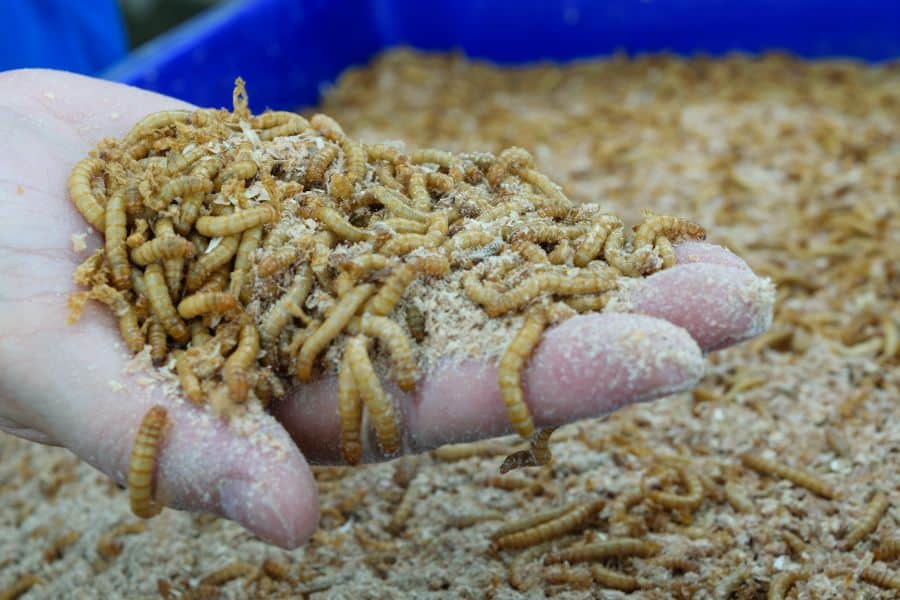When the eggs of one type of darkling beetle hatch, the larvae that emerge are what we call mealworms. These larvae were considered pests in some places because they can eat stored grain.
These beetle larvae have, however, graduated to now being considered an important source of protein for both domesticated and wild animals. They can even be used as bait for fishing.
Both layers and broiler chickens require protein-rich diets and mealworms could be a key source of this protein. Some farmers have even opted to farm their own mealworms at home.
Is it a good idea to feed mealworms to your feathered friends, and what are the challenges of feeding chicken mealworms? Read on as we try to answer these and many more questions regarding mealworms for chickens.
Do Chickens Eat Mealworms?
Chickens will go absolutely nuts over some mealworms. They have been described as being to chicken what chocolate is to many of us, and they can’t get enough of it.
This should not be a surprise because chickens have a naturally wide diet which can consist of anything from grains and grass to insects and small rodents.
Are Mealworms Good for Chicken?
Mealworms contain many nutrients that are essential for the proper growth of chicken’s bodies, feathers, and eggs, and their overall health.
The nutritional profile of mealworms is as follows:
| Nutrient | Live Mealworms (% weight) | Dry Mealworms (% weight) |
| Protein | 20 | 53 |
| Fat | 13 | 28 |
| Fiber | 2 | 6 |
| Moisture | 62 | 5 |
Mealworms can also be a good source of essential minerals such as phosphorus, magnesium, potassium, zinc, selenium, etc. They are also rich in vitamins E and C in addition to Niacin, Folic Acid, Biotin, Choline, and several others.
Due to their nutritional profile, mealworms are considered a healthy treat for chickens to eat in moderation.
It is important to point out that the nutritional profile of mealworms is not constant and can vary significantly depending on what the mealworms are fed.
Additionally, mealworms have low quantities of nutrients like calcium. This means that mealworms alone cannot provide your chickens with the full range of nutrients they need to be healthy.
Are there Health Risks to Feeding Chickens Mealworms?
At this point in time, there is no research that has indicated the existence of a direct health risk in feeding mealworms to chickens.
The main concern raised has been the need for moderation. Due to the nutritional profile of mealworms, chickens that are fed too much of this treat may gain excess weight and suffer digestive problems.
The use of mealworms as a source of protein for chickens is a relatively new concept. Therefore, there is a lot that is yet to be uncovered about the benefits and downsides of feeding them regularly to chickens.
What Exactly are Mealworms?
Mealworms may look like worms, but they are not biological worms. They are simply the undeveloped offspring of the yellow mealworm beetle, scientifically known as Tenebrio molitor.
The yellow mealworm beetle is usually referred to as the darkling beetle. However, it is estimated that there are over 20,000 species of darkling beetles of which the yellow mealworm beetle is just one.
The female beetle lays an average of 500 eggs over its adult life. When these eggs hatch, the larvae that emerge are the treats that are fed to chickens either live or dried.
The larvae will stay in this ‘mealworm’ stage for 8 to 10 weeks before they go into the pupae stage. They will also shed their exoskeletons multiple times before becoming pupae.
The Mealworms are harvested just before they turn into pupae when they are at their largest.
In What Form Are Mealworms Fed to Chicken?

Mealworms can be fed to chickens while still alive or in a dry form. They can be dried in several ways.
Freeze-dried mealworms are dried in low-temperature, low-pressure conditions. Drying using this method helps to preserve the nutritional profile of live mealworms.
Freeze-drying mealworms at home may not be feasible due to the need for special equipment.
Oven-drying and sun-drying mealworms are the alternatives, and these methods use heat to remove water from the mealworms. The overall benefits of mealworms dried using the different methods don’t seem to vary significantly.
Live vs Dried Meal Worms
Some farmers will swear by live mealworms while others say their chickens are okay with either option. Is there any advantage to picking one over the other?
Live mealworms are said to be nutritionally better than dried ones, but dried ones have a higher percentage by weight of nutrients like proteins. The dried mealworms are also easier to store and can last for over a year if stored in airtight containers in a cool and dark spot.
Many farmers have pointed out that the nutritional differences between live and dried mealworms don’t translate to significant differences in the overall health of chickens. The main challenge is that some chickens may prefer the live mealworms to the dried ones.
How Many Mealworms Should You Feed Your Chickens?
Due to their high protein content, it is recommended that each of your chickens doesn’t eat more than 10 mealworms per day. Any amount between 4 and 10 should be okay.
Many farmers will feed their chickens just a handful of mealworms two or three times a week. For bantams, some recommend just treating them to mealworms once every week.
You may also want to rotate the mealworms with other treats as they can be a little pricey.
Can Chicks Eat Mealworms?
Yes, chicks can eat mealworms, but some farmers prefer to wait until they are a few weeks old before offering such treats. If the mealworm is too large to fit in their tiny beaks, they won’t be able to eat it.
For dried mealworms, you could crush them a bit before offering them to the chicks.
How to Raise Your Own Mealworms
The idea of treating your chickens to mealworms may sound great, but mealworms are not cheap, and the costs can quickly add up. This is why some farmers have opted to start raising mealworms for their chickens.
What Do You Need to Start Your Mealworm Farm?
To start farming mealworms, you’ll need:
- Substrate to serve as food e.g., dry cornmeal or oatmeal.
- Source of moisture usually fruits or vegetables. These will provide water for the mealworms and beetles.
- Three plastic containers with lids (drill air holes into the lids)
- Egg cartons and other cardboard pieces.
- Mealworms
Setting Up the Farm
Set up the mealworm farm as follows:
- Add the food substrate to the bottom of each container. The substrate should be between one and three inches thick and serves as both food and bedding for the mealworms.
- Slice the fruits or vegetables and place them inside one container. Carrots are a popular choice because they don’t develop mold as easily as other vegetables and fruits.
- Place the mealworms into this container and add the egg cartons and other cardboard. These will create dark hiding spots for the mealworms.
Running the Farm
The remaining plastic containers will serve as the home for the pupae and the adult beetles. Once you have finished setting up remember the following:
- Check the mealworm container regularly to remove dead insects, moldy food, or rotting vegetables at least once a week or even more often. You should also replenish the dry food and vegetables as required.
- Check the mealworm container regularly for pupae. Any mealworm that moves to the pupae stage should be moved to the pupae container immediately as it will be defenseless.
- Pupae don’t need food or water. You should still have comfortable bedding for them as they’ll be in this stage for one or more weeks.
- Remove any adult beetles that emerge as they will start to eat the other pupae. Place them in the remaining container which should have a similar setup to that of the mealworms.
- Check the adult beetle container regularly for eggs. These are likely to be near the bottom of the container.
- You don’t have to move the eggs, but you should be ready to do so when they hatch. This can take between 4 and 19 days.
- The amount of work will increase with every subsequent generation of mealworms since each female beetle can lay hundreds of eggs.
What Can Mealworms Eat?
Mealworms can eat a surprising number of things. These include grains and vegetables but, as shown in the video below, they can even consume plastic.
Although meat is not their preferred meal, mealworms have been known to eat small amounts of animal matter or even resort to eating other mealworms if they lack food or water. It is not advisable to feed your mealworms animal protein, cardboard, or plastic.
Remember that your mealworms’ nutritional profile will be determined by what you feed them. A poor diet will lead to mealworms with poor nutritional qualities.
Factors to Consider When Raising Mealworms
When you start a mealworm farm, you should keep the following in mind:
- Timelines are variable so take some time to check on the mealworms regularly to ensure their living conditions are good and to move any mealworms, pupae, and beetles to the right container.
- Temperature plays a key role in the rate of development of mealworms during the different stages. A temperature of around 80°F at 70% relative humidity is considered ideal for mealworms.
- Regular harvesting of the mealworms can keep their population manageable, but you can consider long-term storage options if the population is too high.
Why is it Illegal to Feed Chickens Mealworms?
In certain jurisdictions, it is illegal to feed dried mealworms to your chickens. This was notably the case in the UK and EU and this ban was put in place in 2014.
The reason for the ban on feeding mealworms to chickens is that most of the mealworms are imported. There was a fear that these imported mealworms may have been fed animal protein.
Insects fed animal protein could serve as vectors and transmit diseases and parasites between animals and even to humans. The ban came about to avoid a situation like the mad cow disease outbreak in the 80s and 90s that resulted in the deaths of 178 people.
What is the State of the Ban?
Surprisingly, many farmers are unaware that such a ban exists and continue to feed mealworms to their chickens.
Although it remains illegal to feed dried mealworms to chickens in the UK, it is perfectly legal to do so in other countries including the US. The EU also authorized the use of insect protein in poultry feed back in 2021.
Also Read:
Final Thoughts
Mealworms are emerging as a kind of superfood that can boost the protein content of food given to farm animals including chickens.
Currently, many farmers are using this protein-rich food as a treat they can offer their chickens on occasion. Mealworms are not actually worms but the young ones of the yellow mealworm beetle.
Mealworms can be fed to chickens live or after being dried. The main advantage of dried mealworms is that they are easier to store.
Due to the cost of mealworms, many farmers are resorting to raising their own. Farming mealworms is relatively affordable and easy to start. Running the farm properly will require a little bit of time and effort as the mealworm population grows rapidly.
Although it is illegal to feed chickens dried mealworms in some jurisdictions, you can safely give these tasty treats to your feathered friends in many parts of the world.


